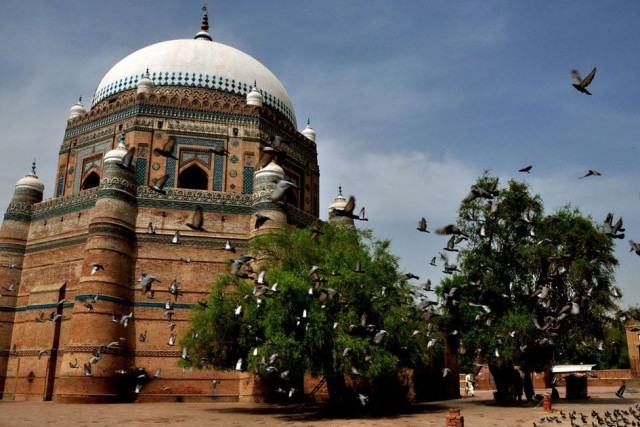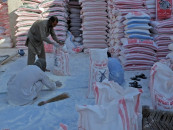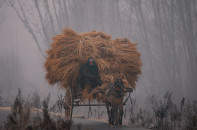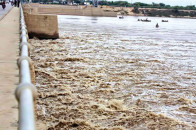Nigar Khana: Multan’s famed spot for art, history lovers
Former president, prime ministers and famous literary figures have visited the place

Photo: File
It is located opposite the mausoleum of great Sufi saint Hazrat Shah Rukn-e-Alam, and is popularly known as House of Art. The place is famous for selling handicrafts, antiquities, cultural and artistic items for over 45 years.
Climbing down the steep stairs of this enchanting locus, one finds himself into a world of colours consisting of mosaic art, Naqashi, wooden and glass work, blue pottery, jewellery made of camel bone, table lamps, flasks, Plaster of Paris decoration pieces and many more items.
Abul Waheed, who has been running Nigar Khana after his father Abdul Hameed for the last 30 years, says that his father, who was a carpenter by profession, had extraordinary command of manufacturing innovative flower pots.
Health awareness walk held in Multan

“Now, many artisans are contributing to it and every one of them is master of his art,” he said.
He added, “Their distinctive approach is a source of attraction and inspiration for a large number of visitors who throng the spot on a daily basis.”
About camel skin work, Waheed claimed that Multan is the only city in the world where this unprecedented art survives.
Former president Ziaul Haq, prime ministers Balakh Sher Mazari, Syed Yusuf Raza Gilani, ex envoys of US, Australia, China, Japan, Argentina and many other countries, besides several literary figures, including Ahmad Nadeem Qasimi, Amjad Islam Amjad and Ataul Haq Qasmi had visited Nigar Khana.
Famous writer Isobel Shaw wrote in his trekking guide ‘Pakistan Handbook’: “The old gun emplacement on the Southern end of the fort mound is a platform with a good view over Shah Rukn-e-Alam's tomb, in one direction, and the old city of Multan in the other. Nearby is the armoury, now a souvenir and pottery shop called Nigar Khana. Steep steps lead into a tomb like interior where you can see a selection of blue pottery and painted camel skin lampshades and vases. If you climb up to the roof, you can watch the artisans paint the camel skin.”
Punjab Finance Minister Aisha Ghaus Pasha also penned down her views in the visitor's book, “I have been delighted to see the rich culture of Punjab and very keen to see it well perceived and widely publicised. Thank you for preserving it for us.”
Waheed said that a large number of visitors start visiting the art house from morning till evening as they are open from 8:30am to 9pm in summers and from 9:30pm to 6:30pm in winters.
He maintained, “In November 1989, then federal minister for tourism Syed Yusuf Raza Gilani visited Nigar Khana and said that tourists would carry pleasant memories with them.”
He urged the incumbent government to allocate a piece of land where all artisans could work under one roof to save time and money.
Multan police beat up elderly couple, drag them through street

About tourists’ interest in purchasing items, he said that women prefer to buy jewellery made of camel bone, elephant teeth, wooden and other decoration pieces, while people coming from other cities buy blue pottery and camel skin articles.
He disclosed that a well-known artisan of blue pottery Ustad Alam had also been working at Nigar Khana.
What historians say?
Historians say that earlier it was Barood Khana of Qasim Fort and was used for storing gunpowder and weapons. It was badly damaged during siege of Multan by British in 1848. Later, Pakistan government converted it into a Nigar Khana or art house for selling handicrafts.
This subterranean domed chamber is believed to have been built in 1720, probably by Sher Afgan, the Naib Nazim of Multan during the rule of Muhammad Shah (1719-1748).
A map prepared during the reign of Nawab Muzaffar Khan (1778-1818) and later on copied by the officials of Nawab of Bahawalpur shows the location of this building situated between Jamia Masjid and Sard Khana and on the south of the Mausoleum of Rukn-e-Alam and quite close to Qasim Bagh Gate.
Both the Barood Khana and Sard Khana are shown as identical buildings each having a dome above ground surrounded by an arched veranda all around. The Sard Khan and the Jamia Masjid have disappeared now, however; the Barood Khan is still there although its arched verandah has also disappeared.
The single entrance is on the northern side which has a staircase that descends into the crossed shaped spacious room some 20 feet below the outside surface.
The light is filtered down through the main entrance and the three windows fitted in the neck of the dome on the remaining sides. This structure survived the devastating powder magazine explosion that destroyed almost all buildings in the fort in 1848. The Barood Khana had been converted into a souvenir shop in 1972.
Published in The Express Tribune, December 5th, 2017.



















COMMENTS
Comments are moderated and generally will be posted if they are on-topic and not abusive.
For more information, please see our Comments FAQ